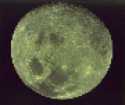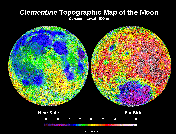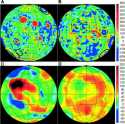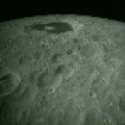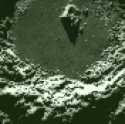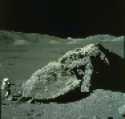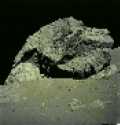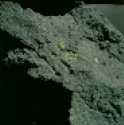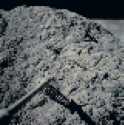NEEP533 Course Notes (Spring 1999)
Resources from Space
Lecture #10: What does the Moon tell us about the Earth?
Evolution of the Moon: The Apollo Model
Visuals
Slides illustrating the phases of lunar evolution and providing reconstructions of various periods.
Notes
Before Apollo 11, up through the completion of the Lunar Orbitor photographic missions and the Lunar Surveyor automated lander and surface analysis missions, we knew a lot about the relative sequence of major events in lunar history but not the span of time each represented.
After the analysis of Apollo 11-17 mission data we now had significant knowledge about the absolute ages of the stages of lunar evolution as well as details of events and processes about which we had never dreamed.
 Apollo Model: Stages of Lunar Evolution
Apollo Model: Stages of Lunar Evolution
Cratering on the Moon: A dominating process!
Almost everything we think we know about the Moon must be viewed through the mask of cratering that has dominated lunar history from its origin to the present. The impact of comets, asteroids, meteors, micrometeors, dust, and energetic particles has modified the surface and near-surface expression of all the internally generated processes that have led to the physical nature of the Moon today.
- Most comet, asteroid, meteor, and micrometeor impact velocities are between 15 and 20 km/sec, giving associated target pressures at the point of impact of several hundred GPa and extraordinary amounts of heat as conversion of kinetic energy into forward and rearward shock waves takes place almost instantaneously. About 98% of the projectile is melted, vaporized, or ionized and returned to space based on the amount of extralunar material that can be identified in the lunar regolith.
- The general characteristics of craters as a function of diameter are
as follows:
<10 m diameter craters (transition up to 100 m diameter) - o normally do not penetrate regolith
- o depth to diameter ratio variable
- o glass-lined pits in center of fresh craters
- o deep pits in the center of some craters
- o inner benches common if target material statified
- o impact breccias present in and outside larger craters
- o depth to diameter ratio variable
- >100m <10 km diameter craters (transition up to 30 km diameter)
- o normally penetrate regolith
- o hemispherical hole with raised rim
- o depth to diameter ratio 1:3 to 1:4
- o ejecta blankets extend to about one crater diameter
- o target strata overturned but preserved in ejecta blanket
- o inner benches and impact breccias associated with smaller craters
- o hemispherical hole with raised rim
- >30 km <100 km diameter craters (see Copernicus)
- o flat floors with central mound or peak
- o slumped (landslide) benches on walls
- o indications of pools and flows of impact melt
- o ejecta blankets extend to about one crater diameter
- o target strata overturned but preserved in ejecta blanket
- o secondary impact craters, crater clusters, and crater chains extent many crater diameters
- o slumped (landslide) benches on walls
- >100 km diameter basins (see Orientale)
- o generally flat, fractured floors with partial of complete inner rings
of peaks
- o slumped (landslide) benches on walls
- o extensive pools and flows of impact melt inside and outside the primary impact crater rim
- o ejecta blankets extend many crater diameters with evidence of significant lateral flow (do lithostatic pressures become a factor in diverting excavation from near vertical to near horizontal?)
- o one to six rings of mountains outside primary impact crater rim (multiring basins generally >400 km in diameter, largest are South Pole-Aitken with a diameter of about 2500 km and Procellarum, 3200 km) .
- o slumped (landslide) benches on walls
Stage One: The Beginning - 4.56-4.57
eons. The Moon formed contemporaneously with the Earth.
Stage Two: The Magma Ocean - 4.56-4.4(?)
eons. Accretionary melting, due to conversion of kinetic energy
to heat, FexNiySz liquid migration towards
the Moon's center, and the decay of short lived radioisotopes (e.g. 26Al,
182Hf, etc.) created an approximately 500 km deep magma ocean.
Loss of some elements and redistribution of others in this magma ocean (differentiation) occurred because of volatile depletion due to high temperatures and low gravity, and crystal settling and floating as the magma ocean cooled.
Reaction of migrating iron liquid with any accreted water in the unmelted lower mantle to produce hydrogen and FeO probably would be sufficient to eliminate any remaining internal indigenous water from the entire Moon as no evidence of such water has be found in Apollo samples.
- The one of the oldest rocks sampled by Apollo astronauts - about 4.45 +/-0.1 billion years old (see figure to the right, above).
- The environment during the formation and crystallization of the Magma
Ocean was clearly extraordinary.
The deposition of accretionary energy into the outer 500 km of the Moon not only caused the in-falling material to melt but resulted in the continued violent stirring and splashing of this melt even as it crystallized.
The high temperatures of the silicate magma and the low gravitational forces caused the loss of volatile and low atomic number elements to space relative to chondritic C1 and Earth and Mars abundances.
Further, as cooling was finally able to begin through the radiation of heat into space, gravitational forces would imposed convection on this regime.
Finally, some modest addition of heat would occur as immiscible FexNiySz liquid moved downward to the floor of the Magma Ocean. Apollo seismic and magnetic evidence suggests a fluid or partially fluid core about 500 km in radius at the present time (Taylor, 1982), although no global magnetic field is detectable. This size has been recently confirmed by Lunar Prospector measurements of the polar moment of inertia which is consistent with a core radius between 300 and 450 km (Konopliv, et al., 1998)
- As differentiation by crystallization proceeded and plagioclase began to float and accumulate as a protocrust, the violence continued, stirring the plagioclase back into the changing magma and adding the "ferroan" component (relatively iron-rich magnesium silicates as minor minerals) to the over-all anorthositic character of the final crust. This process also depleted Ca and Al in the remaining liquid which would account for the lack of a garnet signature in the mare basalts, the product of later partial melting of the deep upper mantle (Basaltic Volcanism, 1981)
- Olivine and Ca-clinopyroxene moved to the base of the Magma Ocean as they began to crystallize with a consequential enrichment of the Magma Ocean in iron, potassium, refractory trace elements, long-lived radioisotopes, remaining volatiles, and apparently titanium.
- During the period of Magma Ocean crystallization when the crust was
not coherent or thick enough to resist the penetration of impactors, magma
was splashed onto and into the crust. Once this process ceased, the rebound
of the top of the remaining Magma Ocean in response to impactors into the
crust would result in "splash" intrusions into the lower crust.
The solidified remenents of those intrusions have been identified by remote
sensing techniques in the central peaks of various craters formed during
Mature Crust Stage (see Lecture 11) and many Apollo samples of the Mg-suite
(crystalline norites, troctolites, dunites, anothosites, etc.) probably
have been derived from such bodies by large impacts. They all appear to
have crystallization ages between 4.2 and 4.5 by (See Wilhelms, 1987, Table
8.4)
This hydrogen would tend to migrate upwards, along with other relatively low temperature volatiles (Cl, F, N, etc.) and may have influenced the partial melting of the upper mantle during Stage Six, become the dominant volatile that formed vesicules in the erupted basalts of that stage, and been a major component in the volatiles that drove the explosive eruptions of lunar pyroclastics (see below).
Such hydrogen would be consistent with Delano's (1990) experimentally derived contention that the source region for mare basalts is strongly reducing chemically.
 |
 |
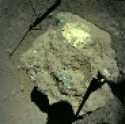 |
| |
|
|
 |
Schematic representation of the interior of the Moon showing Hf-W systematics (data from Lee, et al., 1997, Table 1) relative to the period 4.44 to 4.0 billion years. |
- SUMMARY OF Hf-W SYSTEMATICS FOR THE MOON - 4.55-4.0 BY
- SIGNIFICANT LOSS OF FROM THE MAGMA OCEAN WILL OCCUR WITH THE EARLY SEPARATION AND DOWNWARD MIGRATION OF FexNiySz LIQUID.
- MOST 182Hf WILL DECAY TO 182W (HALF-LIFE 9M YEARS)
BEFORE CRYSTALLIZATION OF THE BULK OF THE MAGMA OCEAN.
- THE CLOSING OF THIS SYSTEM IN THE MAGMA OCEAN MAY BE REFLECTED IN THE ~45 MY MODEL AGE IT GIVES FOR THE APOLLO 17 CLEAN ORANGE GLASS (APPARENTLY DERIVED FROM THE DEEP UPPER MANTLE) AND THE APOLLO 15 OLIVINE BASALTS (APPARENTLY DERIVED FROM THE LOWER PORTIONS OF THE UPPER MANTLE) BOTH OF WHICH APPEAR TO HAVE BEEN PRODUCED BY THE PARTIAL MELTING OF EARLY CUMMULATES IN THE MAGMA OCEAN THE MODEL AGE OF WHICH IN TURN MAY REFLECT THE END OF 184W AND 182W REMOVAL BY FexNiySz LIQUID.
- THE COMPOSITION AND MODEL AGES (~67 MY) OF APOLLO 17 NORITES AND AN APOLLO 16 Mg-GRANULITE (APPARENTLY DERIVED FROM SPLASH INTRUSIONS FROM THE MAGMA OCEAN INTO THE LOWER CRUST) MAY INDICATE THE CLOSING OF THE Hf-W SYSTEM IN THE THERMALLY AND DYNAMICALLY MORE AGITATED UPPER MAGMA OCEAN.
- THE ISOTOPIC PROPORTIONS IN APOLLO 16 FERROAN ANORTHOSITES (APPARENTLY
DERIVED FROM THE UPPER CRUST) MAY INDICATE THE OVER-ALL PROPORTIONS IN
THE UPPER CRUST.
- THE HIGHER PROPORTIONS OF 182W IN THESE ROCKS MAY INDICATE
THAT THE CRUST HAD BEGUN TO FORM BEFORE ALL 182Hf HAD DECAYED.
THEIR MODEL AGE OF ~53 MY MAY REFLECT THE TIME OF ISOLATION OF AN INCREASINGLY
COHERENT UPPER CRUST FROM THE MAGMA OCEAN.
- THE HIGHER PROPORTIONS OF 182W IN THESE ROCKS MAY INDICATE
THAT THE CRUST HAD BEGUN TO FORM BEFORE ALL 182Hf HAD DECAYED.
THEIR MODEL AGE OF ~53 MY MAY REFLECT THE TIME OF ISOLATION OF AN INCREASINGLY
COHERENT UPPER CRUST FROM THE MAGMA OCEAN.
- THE VERY HIGH Hf AND W IN THE APOLLO 15 KREEP BASALTS INDICATE THE
CONCENTRATION OF THESE REFRACTORY ELEMENTS IN THE RESIDUAL LIQUIDS OF THE
MAGMA OCEAN.
- THEIR MODEL AGE (~53 MY) MAY INDICATE WHEN THESE LIQUIDS BECAME A CLOSE
SYSTEM, I.E., ABOUT THE SAME TIME AS THE UPPER CRUST. THIS SUGGESTS
THAT THE MAGMA OCEAN MAY HAVE BEEN LARGELY CRYSTALLIZED AT THIS TIME EXCEPT
FOR THESE RESIDUAL LIQUIDS.
- THEIR MODEL AGE (~53 MY) MAY INDICATE WHEN THESE LIQUIDS BECAME A CLOSE
SYSTEM, I.E., ABOUT THE SAME TIME AS THE UPPER CRUST. THIS SUGGESTS
THAT THE MAGMA OCEAN MAY HAVE BEEN LARGELY CRYSTALLIZED AT THIS TIME EXCEPT
FOR THESE RESIDUAL LIQUIDS.
- THE VERY HIGH 182W AND 180Hf APOLLO 11 OLD HIGH Ti BASALT MAY INDICATE THAT BOTH Hf ISOTOPES WERE CONCENTRATED IN THE LATER LIQUIDS THAT CRYSTALLIZED INTO THE UPPER PORTIONS OF THE UPPER MANTLE.
- THE DISTINCTIVE ISOTOPIC PROPORTIONS IN THE APOLLO 17 BULK ORANGE GLASS
(APPARENTLY RELATED IN PART TO THE VOLATILES ON THE SURFACES OF THE GLASS
SPHERES) SUGGEST A SOURCE REGION DISTINCT FROM OTHER BASALTS. THIS IS CONSTANT
WITH OTHER INDICATIONS THAT THESE VOLATILES WERE DERIVED FROM BELOW THE
UPPER MANTLE.
The above analysis and interpretations rest in part on the assumption that radioactive 182Hf was created shortly before the accretion of the terrestrial planet, including the Moon. The apparent consistency of Hf/W systematics and the derived model ages with a plausible detailed model for the evolution of the Moon lends support for the origin of 182Hf, 26Al (daughter 26Mg found in C1 chondrites) having been in a near-by supernova that was coincident in timing with and possibly responsible for the collapse of the interstellar cloud that became the solar nebula (see Cassen and Woolum, 1999, p 56).
- Major Issue: Although probably created by the accumulation of planetismals of varying composition, how homogeneous did the Magma Ocean become as it was stirred by continuing and increasingly energetic accretion and convection?
- Spectroscopic analysis of Clementine and Galileo images of deep impact basins on the lunar far-side from which significant depths of crustal material have been removed suggest that the most of the present crust is more chemically heterogeneous than that exposed at the surface.
- Similar heterogeneity has been mapped by Pieters in much smaller craters (see Nozette, et al., 1994, p1844-1848) using Clementine and telescopically gathered spectra.
- Rather than suggesting that the deep impacts penetrated 50-70 km of crust to excavate lunar mantle material (P. G. Lucey et al., 1994 in Nozette, et al., 1994 and, 1996, as reported in Science News, 149, 204), these heterogeneities may reflect the mixing of Magma Ocean melt at various stages of differentiation with the still forming crust, an extremely dynamic process that was occurring as the crust formed on the still partially molten mantle.
- Stage Three: The Cratered Highlands - 4.4(?)-4.2(?) eons. Impacts of comets, asteroids, and other debris, capable of forming craters at least 50 km in diameter, saturated the surface of the lunar crust once it was capable of supporting itself over the residual liquids of the magma ocean. (Note: Oldest identified Earth crust is at least 4.0 eons old.)
This breaking, fusing, and mixing of the upper 4-5 km of the upper crust, and the extensive fracturing of the the next 5 or so km below, created a thermally insulating layer over the entire Moon without which remelting of the upper mantle in Stage Six could not have occurred.
Once crystallized from the Magma Ocean, and without the addition of new energy or a reduction in lithostatic pressure, the the mantle could not remelt. This need for new energy or reduced pressure was exacerbated by the concentration of radioisotopic heat sources in the residual liquid and the gradual migration of that liquid upwards toward the base of the crust.
With the insulating layer represented by the Cratered Highlands, and the consequent reduction in heat conduction to the surface, heat could begin to accumulate below the crust , keeping the accumulating residual liquid molten and gradually increasing the temperature at progressively lower zones of the upper mantle.
After few hundred million year long period of magma ocean/upper mantle cooling and contraction, a comparably long period of upper mantle heating and expansion began. This heating and expansion began to be counteracted by the movement of basalt magma to the surface during Stage Six.
It is likely that the regional release of lithostatic pressure in the upper mantle by basin forming events in Stages Four and Five generally accelerated the initial partial melting of underlying portions of the upper mantle.
 |
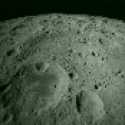 |
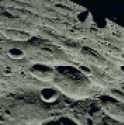 |
- Hot and gas mobilized flows of fine impact debris radiating from Large Basin forming impact events (Stages Four and Five)?
- Pre-Mare Basalt (Stage Six), volatile driven eruptions of the very
earliest initial partial melting components of the mantle with entrained
crustal debris?
- These volatiles may have been dominated by hydrogen, migrating upward after being produced by the breakdown of water as iron rich liquids moved through the lower mantle (see Stage Two discussion).
Stage Four: The Old Large Basins/Crustal Strengthening - 4.2(?)-3.9 eons. The Old Large Basins/Crustal Strengthening - 4.2(?)-3.9 eons. More than 30 large impact basins formed, but rapid crustal and mantle adjustment (isostatic compensation) occurred so that no mass concentrations remain (see Stage Five, below).
- Figure: Map of Nearside Young Large Basins (Nectarian System) (Wilhelms, 1987)
- This period of old large basin formation, however, triggered a strengthening of the crust as indicated by the presence of nearly four billion year old mass concentrations in younger large basins.
The strengthening was probably due to potassium, rare earth elements, and phosphorus-rich residual liquids (urKREEP), left over from the crystallization of the magma ocean, moving in response to fracturing beneath the large basins from the mantle-crust boundary, a strengthening process in and of itself, and into the crust where it crystallized into interlocking dikes within the myriad of crustal fractures.
Major Issue: When did the event take place that created the largest of the old large basins, the now vague but none the less huge (more than 3200 km in diameter) Procellarum Basin on the near side of the Moon?
Wilhelms (1987) and Wieczorek and Phillips (1998) provide lunar mapping and lunar gravity interpretations, respectively, that strongly indicate that the roughly circular region of the Moon, the Procellarum Basin, that underlies Mare Procellarum, Sinus Roris, Mare Imbrium, and a number of smaller maria reflects a very large basin forming event that pre-dates all other identifiable old large basins.
Ejecta from the Procellarum event, combined with that from the later, nearly as large South Pole-Aiken event (see discussion below), created the thickest lunar crust we see today.
The event, however, may have removed most of the young Cratered Highland crust beneath the region, requiring that a new insulating zone of brecciated crust be developed before upper mantle temperatures below the region could reach the point of partial melting.
This in turn may explain why the mare basalts of the region are apparently younger (3.2-3.5 by with some crater counting suggesting even younger flows in the western portion of the basin) than most of those to the east.
There is no evidence in the Lunar Prospector global gamma ray spectrometer analysis (Lawrence, et al., 1998) that any KREEP materials were excavated by the Procellarum event even though the later Imbrium event, occurring within the Procellarum Basin, was responsible for the wide spread distribution of KREEP material on the near side of the Moon.
This suggests that the Procellarum event occurred before urKREEP had moved upward into the crust and may have been responsible for triggering that movement in this region of the Moon.
On the other hand, Lunar Prospector thermal neutron data (Feldman, et al, 1998) indicates a probable iron + titanium-rich annulus just outside the rim of the Procellarum Basin. This material, representing the deepest excavated, may be from the potentially abundant splash intrusions (Fe and possible Ti-rich liquids from the Magma Ocean during Stage Two) present in the lower portions of the crust.
Major issue: When did the event occur that formed the South Pole Aiken
Basin, a 2500 km diameter basin over 12 km deep at its deepest, and what
were its consequences?
First detected in bits and pieces of out of place mountain arcs in pre-Galileo photographs by Earth-based lunar mappers (Wilhelms, 1987), conformatory data and images of South Pole-Aiken have been gathered by Galileo, Clementine and Lunar Prospector. This information has confirmed that mare basalts are largely absent from the floor of the basin (Feldman, et al., 1998) and KREEP containing materials are large absent from the region (Lawrence, et al., 1998).
A possible explanation for the absence of both significant mare basalt and KREEP in or around the basin may lie in the South Pole-Aiken event occurring after most of the Cratered Highlands had formed, thus removing most or all of the insulating layer which in turn would prevent the accumulation of the heat necessary to partially melt the upper mantle beneath the region to create basalt magmas. The non-mare dark albedo surfaces within the basin (some iron, little titanium, small amounts of potassium and thorium based on Clementine and Lunar Prospector sensing) may be related to impact melts, related to both South Pole-Aiken and younger large basins within its borders, of mixtures of anothositic crust and splash intrusions. The absence of a significant KREEP signal makes it seem unlikely that these surfaces could be related to magmas from either the incompletely solidified Magma Ocean or its residual liquids
As with Procellarum, the absence of significant KREEP around the basin is explained in this scenario by the South Pole-Aiken event occurring before the movement of the urKREEP residual liquids into the lower crust. As with Procellarum, Lunar Prospector thermal neutron data (Feldman, et al., 1998) indicates a probable iron + titanium-rich annulus just outside the rim of the Procellarum Basin. This material, representing the deepest excavated, may be from the potentially abundant splash intrusions (Fe and possible Ti-rich liquids from the Magma Ocean during Stage Two) present in the lower portions of the crust.
Stage Five: The Young Large Basins -
3.9-3.8 eons. An additional 10-12 large impact basins, more crisp
and sharply circular that the more numerous earlier basins, formed when
the crust was strong enough to support central mass concentrations and rim
deficiencies indefinitely (see Wilhelms, 1987).
- Figure: Map of Nearside Young Large Basins (Lower
Imbrian System) (Wilhelms, 1987)
- Figure: Map of Farside Young Large Basins (Lower Imbrian System) (Wilhelms, 1987)
- Figure: Map of Nearside Young Large Basins (Upper Imbrian System) (Wilhelms, 1987)
- Figure: Map of Farside Young Large Basins (Upper Imbrian System) (Wilhelms, 1987)
- Figure: Map of Farside Young Large Basins (Lower Imbrian System) (Wilhelms, 1987)
 |
Changes to Major Lunar Features: End of the Young Large Basin Stage |
- The best fit of gravity data to a masscon model results from taking
the mare basalt fill as a flat plate of given thickness and density with
some upward central displacement of an upper mantle mass (as much as 25
km above non-mascon areas) and downward circumferential displacement of
the mantle around that mass.
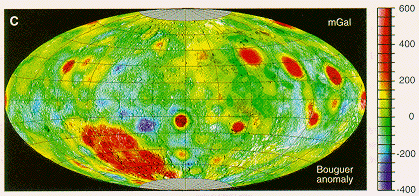 |
|
- The ejecta of young large basins was studied and sampled by Apollo 17 in the Valley of Taraus-Littrow, a radial valley that cuts the rim of the Serenitatis Basin. It as found that both melted and unmelted ejecta and intrusions are created by these events. The melted ejectal and intrusions are viscular, probably the result of the incorporation of hydrogen in the crust.
- The young large basins also may have accelerated partial melting in the upper mantel by temporarily lowering lithostatic pressure belows the basin. If the mantle were near its partial melting point at a point along the column beneath the basin, magma could form and, indeed, volatiles could be released deep within the Moon (see Stage Six discussion in lecture 11).
 |
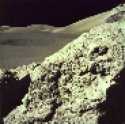 |
 |
||
- The above figures relate to a contact between an older, blue
gray breccia unit (rock made up of pieces of other rock) and a younger
brown-gray, visicular unit.
- One of the apparent findings of the Lunar Prospector Mission (Lin, et. al, 1998). has been an apparent correlation between the large areas of residual magnetism on the far side of the Moon, discovered by subsatellite magnetometers deployed by Apollos 15 and 16, with the antipodes (opposite farside points) of the Imbrian and Serenitatis basins.
 |
Far side areas of remenent magnetism and their correlation with the antipodes of Imbrium and Serenitatis Basins (dotted circles) |
- If this correlation with Imbrian (3.87 by) and Serenitatis (<3.92 but >3.87 by) is valid and not coincidence, it suggests that circulation in the lunar core to produce a global magnetic dipole field began and ended in a period of less than 100 my around 3.9 by ago. This might represent the point at which downwardly migrating FexNiySz liquid (see Stage Two discussion, above) finally created a core of the critical size with a sufficiently high temperature to briefly sustain a dynamo circulation.
- Major Issue: Lunar-wide cataclysm at 3.9 eons or not (see Spudis, 1996,
141-147).
- Most, but not all, Apollo highland breccia samples point to a maximum age of brecciation at about 3.9 billion years - is this evidence of a lunar-wide cataclysm at that time or of a bias in the sampling to areas affected by Young Large Basin forming events?
- The sense of continuum in the for-going discussion would suggest that ejecta from the Imbrium event (3.9 by) has biased the sample from the six Apollo landings. This is particularly true in light of a few highland breccia samples that are significantly older than 3.9 by.
- Major Issue: What insight does the evolution of the Moon give us about
the conditions on Earth, and possibly on Mars, as complex organic molecules
appeared, evolved to self-replication and life began?
- Carbon isotopic evidence (Mojzsis, et al., 1996) indicates that biological processes were modifying isotopic ratios on Earth at least by 3.85 billion years ago and fossil evidence indicates that complex one cell life forms were abundant by 3.5 billion years ago (Schopf, 1993), suggesting that the earliest biological evolution occurred within the space environment of lunar Stage Five or earlier.
- The implications are very strong that the surface of the Earth was exposed to the same extraordinary level of violence, transient energy release, rock pulverization, glass formation, and space contamination as was occurring on the Moon during this period.
- The surface environment of the Earth differed from that of the Moon primarily in the six time greater force of gravity and thus the presence of a water-rich fluid sphere.
- Sheet structure minerals (clays) were probably the most abundant mineral species to which organic and/or biological molecules were exposed in this initial evolutionary environment.
- Disruptions, if not restarts, of the evolutionary processes may have
occurred frequently until after 3.8 billion years ago, i.e., the end of
large basin formation on the Moon and thus probably on the Earth.
Text
Evolution of the Moon: The Apollo Model
Originally published by the author in American Mineralogist, v 76, 773-784, 1991.
Questions
1. What is the best evidence that the Moon was not pulled from the Earth (leaving the Pacific Ocean Basin in its wake) since life evolved on the Earth? Explain.
2. What explanation(s) can you give for the concentration of ages of samples of lunar impact breccias around 3.9 eons other than a cataclysm at that time?
3. Give a geophysical explanation for the mass concentrations (mascons) and mass deficiencies in and around young large basins on the Moon and what conditions are necessary for them to persist for almost 4.0 billion years. Contrast with the Earth.
References
Alfven, H., and Arrhenius, G., 1972, Origin and Evolution of the Earth-Moon System, The Moon, v 5, 210-230.
Basaltic Volcanism Study Project, 1981 Basaltic Volcanism on the Terrestrial Planets, Pergamon Press, New York, 585-591.
Bowring, S.A., and Housh, T., 1005, The Earth's Early Evolution, Science, 269, 1535-1540.
Cassen, P., and Wooum, D.S., 1999 The origin of the Solar System, in P.R. Weissman, McFadden, L., and T.V. Johnson, editors, Encyclopedia of the Solar System, Academic Press, San Diego, 35-64.
Cooper, H.S.F., 1970, Moon Rocks, Dial, New York, 197p.
Delano, J.W., 1990, Pristine lunar glasses: A 'window' into the Moon's mantle, in J.W. Delano and G.H. Heiken, editors, Workshop on Lunar Volcanic Glasses: Scientific and Resource Potential, LPI Technical Report 90-02, Lunar and Planetary Institute, Houston.
Feldman, W.C., Barraclough, Maurice, S., Elphic, R.C., Lawrence, D.J., Thomsen, D.R., and Binder, A.B., 1998, Major Compositional Units of the Moon: Lunar Prospector Thermal and Fast Neutrons, Science, 281, 1489-1493.
Head, J.W., et al., 1993, Lunar Impact Basins: New Data for the Western Limb and Far Side (Orientale and South Pole-Aitken Basins) from the First Galileo Flyby, Journal of Geophysical Research, v 98, 17149-17181.
Hartmann, W.H., 1986, Origin of the Moon, Lunar and Planetary Institute, Houston.
Konopliv, A.S., Binder, A.B., Hood, L.L., Kucinskas, A.B., Sjogren, W.L., and Williams, J.G., 1998, Improved Gravity Field of the Moon from Lunar Prospector, Science, 281, 1476-1480.
Lawrence, D.J., Feldman, W.C., Barraclough, B.L., Binder, A.B., Elphic, R.C., Maurice, S., and Thomsen, D.R., 1998, Global Elemental Maps of the Moon: The Lunar Prospector Gamma-Ray Spectrometer, Science, 281, 1484-1485.
Lee,D.C., Haliday, A.N., Snyder, G.A., and Taylor, L.A., 1997, Age and Origin of the Moon, Science, 278, 1098-1103.
Lin, R.P., Mitchell, D.L., Curtis, D.W., Anerson, K.A., Carlson, C.W., McFadden, J., Acuna, M.H., Hood, L.L., and Binder, A. B., 1998, Lunar Surface Magnetic Fields and their Interaction with the Solar Wind: Results from Lunar Prospector, Science, 281, 1480-1484.
LPI, 1988, Workshop on Moon in Transition: Apollo 14, KREEP, and Evolved Lunar Rocks, LPI Technical Report Number 89-03,156p.
LPI, 1992, Workshop on the Physics and Chemistry of Magma Oceans from 1 Bar to 4 Mbar, LPI Technical Report Number 92-03, 79p.
Mojzsis, S.J.., et al., 1996, Nature, November 7
Nozette, S., et al., 1994, The Clementine Mission to the Moon, Science, 266, 1835-1862.
Peterson, I, 1993, A Rocky Start, Science News, 143, 190-191
Schopf, J.W., 1993, Science 260, 640.
Shoemaker, E.M., 1962, Interpretation of lunar craters, in Zdenek Kopal, editor, Physics and astronomy of the Moon, P. 283-359, Academic Press, New York.
Spudis, P.D., 1996, The Once and Future Moon.Smithsonian, p 157-169.
Taylor, S.R., 1982, Planetary Science: A Lunar Perspective, Lunar and Planetary Institute, Houston, 481p.
Taylor, S.R., 1999,
Wilhelms, D. E., 1987, The Geologic History of the Moon, U.S. Geological Survey Professional Paper 1348, U.S. Government Printing Office, Washington, 302p.
 |
|
University of Wisconsin Fusion Technology Institute · 439 Engineering Research Building · 1500 Engineering Drive · Madison WI 53706-1609 · Telephone: (608) 263-2352 · Fax: (608) 263-4499 · Email: fti@engr.wisc.edu |
Copyright © 2003 The Board of
Regents of the University of Wisconsin System.
For feedback or accessibility issues, contact
web@fti.neep.wisc.edu.
|
 Pre-Apollo Model for Lunar Evolution
Pre-Apollo Model for Lunar Evolution 
